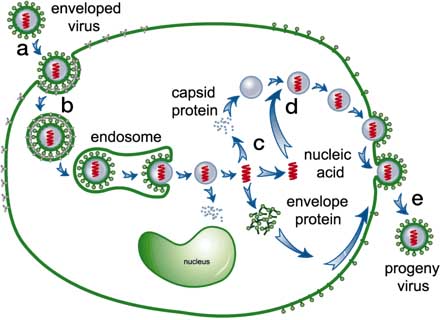 | ||||
Virus Structure, Classification & Reproduction - P2
You have free access to a large collection of materials used in a college-level introductory Cell Biology Course. The Virtual Cell Biology Classroom provides a wide range of free educational resources including Power Point Lectures, Study Guides, Review Questions and Practice Test Questions.
Intracellular and Extracellular Viral Form
Viruses exist in one of two states; extracellular and intracellular.
- Extracellular State: Before it invades a host cell, a virus is in the ‘extracellular state’. An extracellular virus is called a virion (vie-ree-on). In this form, the virus consists of a protein coat (capsid) surrounding nucleic acid. In addition, some viruses have phospholipid envelope surrounding the capsid. This outermost layer provides protection and recognition sites for host cells.
- Intracellular State: Once the virus invades a host cell it is in an ‘intracellular state.’ In this state, the capsid is removed and the virus exists as only as nucleic acid (genetic material).
SCIENCE PHOTOS
SPO VIRTUAL CLASSROOMS
How Do Viruses Reproduce?
Viruses reproduce via four basic steps. Viral reproduction includes:
- Delivery of the viral genomes into a host cell
- Commandeering of the host cell transcription and translation machinery
- Use of the host cell’s building blocks to copy viral genomes and synthesize viral proteins
- Viral genomes and proteins then self-assemble and exit host cells as new infectious particles.
Diagram of how some bacteriophages infect bacterial cells (Not to scale; bacteriophages are much smaller than bacteria).
You have free access to a large collection of materials used in a college-level introductory microbiology course. The Virtual Microbiology Classroom provides a wide range of free educational resources including PowerPoint Lectures, Study Guides, Review Questions and Practice Test Questions.
The SPO website is best viewed in Google Chrome,
Microsoft Explorer or Apple Safari.
Page last updated: 8/2015
PAGE 2 < Back to Page 1
End of Article
Example of a Virus: The Common Cold
The common cold is caused by a family of viruses called Rhinoviruses. Cold virus spreads from infected persons through the air and land on your nose and throat when you breathe in infected air.
When your body ‘realizes’ that it is infected with a virus, inflammation occurs as your body tries to eliminate the virus. The fever and other miserable cold symptoms that you experience are created by your body as a response to the viral invasion.
Sources & Resources
- Bauman, R. (20014) Microbiology with Diseases by Taxonomy 4th ed., Pearson Benjamin Cummings.
- Park Talaro, K. (2008) Foundations in Microbiology. McGraw-Hill.
- Virus Structure Lecture Main Page from the Virtual Microbiology Classroom.
- Virus Life Cycle Lecture Main Page.
- Ebola Virus Disease Main Page, Centers for Disease Control.
- HIV / AIDS Main Page, Centers for Disease Control.
- "World's Largest Virus Just Resurrected from 34,000 Year Old Permafrost", Smithsonian, 2014.
From the throat, the Rhinovirus tricks your cells into making more of viruses which then fly out of you with the aerosol of a sneezes to infect those around you.






